
Baby, it’s cold outside, but that doesn’t mean you can’t find and catch big old redfish stacked up and waiting for you to offer them a bite to eat.
Biting north winds pushed water from the already shallow marshes, turning many ponds into little more than squishy mudflats. Tiny ice particles sparkled like diamonds against the black delta mud when hit by the brilliant, but chilly, post-frontal sunshine.
On those cold January days, most Louisiana sportsmen would probably either head to their favorite duck pond or stay home by the heater. Such days, though, can produce good fishing for hardy spot-tailed marsh marauders.
“Cold water doesn’t bother redfish as much as it does trout,” stated Troy Nash with South Louisiana Redfishing (337-412-5950, www.southlouisianaredfishing.com) in Lafayette who fishes the Vermilion Bay area. “They’re pretty resilient. We seldom see a fish kill for redfish after a severe frost. We find them up in the shallows on the coldest days.”
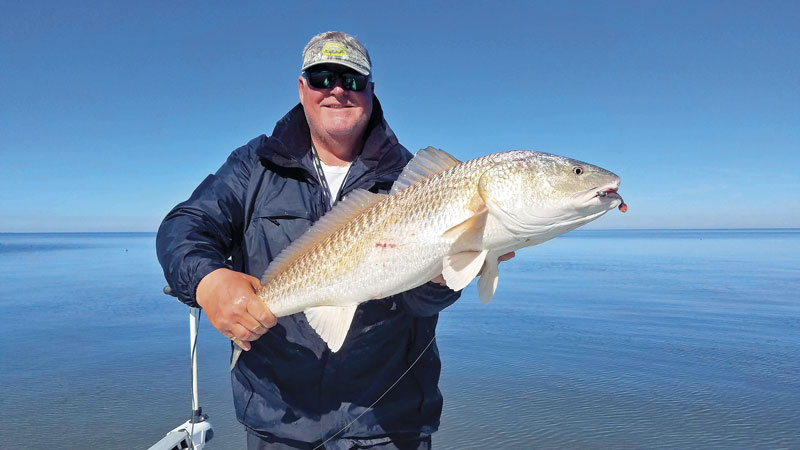
“Finding” becomes the crucial word when chasing Louisiana redfish during the chilly months. First, anglers must locate warmer water and bait. Both remain scarce during the coldest months, so any honey hole with the right combination of water temperatures and prey for the spot-tailed predators could offer excellent cold water action. In the right place, redfish stack up in huge numbers on the coldest days.
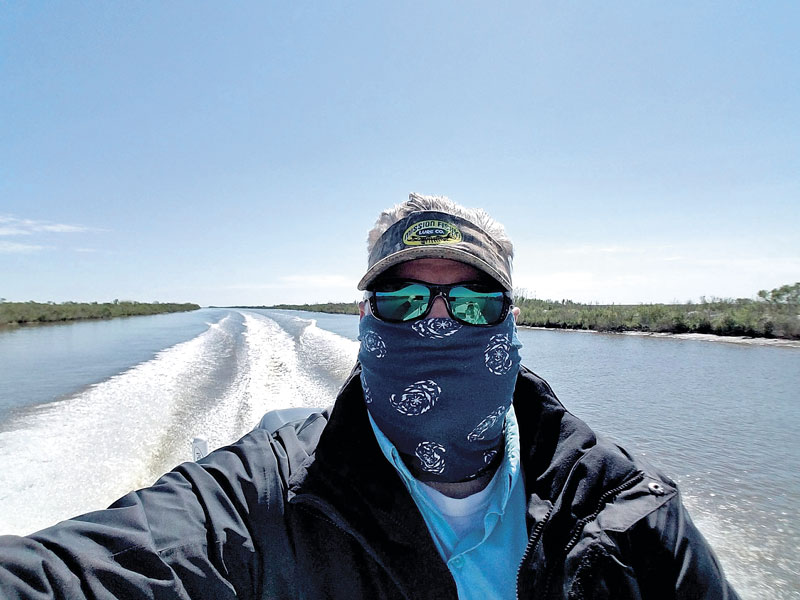
“In January, redfish aren’t as active as they are in the warmer months,” Nash said. “When it’s chilly, the fish are just trying to find a place to stay warm. Often, redfish hunker down in the mud and don’t want to move. There isn’t as much bait in the winter so when people find bait, redfish will find it too. I look for bigger mullet.”
“Warmer” water doesn’t mean bathtub refreshing. To cold-blooded creatures like redfish, a temperature change of just a few degrees could make an enormous difference in how they act.
Redfish feel the warmth
“To a redfish, one degree of water temperature change is like a 10-degree ambient temperature change for us,” explained Charlie Thomason with Bayou Charters (504-278-3474, www.bayoucharters.com) who operates out of lodges in Hopedale. “Redfish get really lethargic when water temperatures drop below 48 degrees, but if the temperature rises five degrees, that’s like a 50-degree change for us. That feels warm to them. Even though the water is still super cold, when the temperature moves up a few degrees, the fish start feeding more actively.”
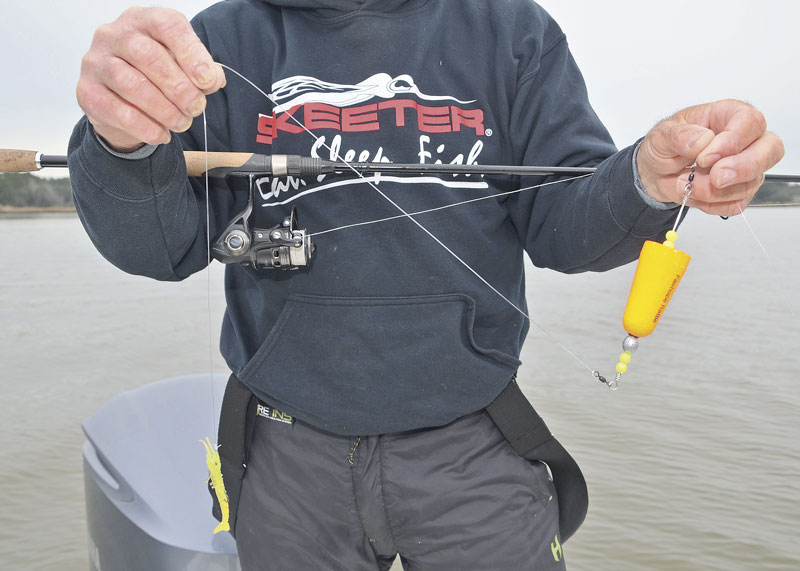
During the coldest times, many redfish drop into the deepest water they can find. Where a depth of three feet constitutes a hole, a canal can seem like a bottomless pit. Thousands of miles of canals slash across southern Louisiana. Many lead to petroleum wells or other structures. In addition, weirs and dams cap some of them. These hard structures absorb solar heat and radiate that energy into the water, which could raise the adjacent temperature a few degrees. Thousands of redfish might congregate around these structures in the winter.
“Those hard objects hold heat, especially rocks,” Nash detailed. “Anytime someone can find a structure big enough to hold heat, that’s a great place to fish in the winter. People need to be accurate casters because the fish hug right up against those structures. I like to get close to the structures and throw down the length of them.”
Fish these deeper canals during the coldest part of the day when the tide falls. Lowering water levels concentrate fish in the deepest channels. In the frigid water, lethargic redfish typically won’t chase baits far or fast. Drop baits as close to the structures as possible and work them painfully slowly along the bottom.
“The winter slows everything down,” Thomason commented. “Mostly, we fish slow moving baits, like plastics on a jighead. Those fish are on the bottom, not swimming around or chasing anything. Rub that bait on the bottom, causing a commotion by hitting shells or the mud. When it causes a bit of commotion, fish get curious. If it sees what it thinks looks like a crab or minnow going along the bottom, a redfish will instinctively grab it.”
How redfish feed
Redfish normally feed more by smell or feel than sight. Some people tip a lure with a piece of shrimp for flavor or soak it in commercial fish-attracting scents. Since it gives off its own scent, a Gulp! bait makes a wonderful temptation. Unlike a regular artificial lure that anglers must keep moving, people can catch reds on Gulp! baits sitting perfectly still on the bottom because redfish react to the scent like they would to a natural bait.
A live cocahoe minnow on a jighead makes a superb winter redfish enticement. Hook it through the eyes or up through the bottom lip and out the top lip. Toss the jighead toward the shoreline and let it sit for a few seconds. Pull it over the drop-off edge. Redfish frequently hover just over the drop-off lip and might snatch a bait as it sinks. Then, drag it a foot along the bottom. The jighead creates a mud trail that redfish can follow. Let the bait sit still for excruciatingly long periods. The struggling minnow frantically swishing its tail creates all the action necessary.
“Fishing around those hard structures is a good place to start in the morning,” Nash advised. “Then, I fish the deeper parts of the channels and the mouths of little bayous.”
Redfish wait at the mouths of tributaries or passes connecting canals to deeper waterbodies or draining marshy ponds. Facing into the flow, redfish wait to pounce on anything the tide brings them to eat. Some people tip a popping cork rig with shrimp, crab pieces or artificial baits. Toss the rig as far upstream as possible so it drifts naturally downstream.
Good tidal movement periodically pours through the deeper canals and passes. The flow commonly carries small crabs swimming along near the surface. Few redfish ever pass up an opportunity to crunch a crab, but they especially rely on the crustaceans during the winter.
“In the winter, redfish eat a lot of crabs because there isn’t much shrimp or baitfish around,” Nash said. “When crabs move, the redfish are on them. If we catch a crab, we take off the top shell, crack the body in half and use the halves for bait. In the winter, redfish will more likely hit smaller baits because their metabolism is low.”
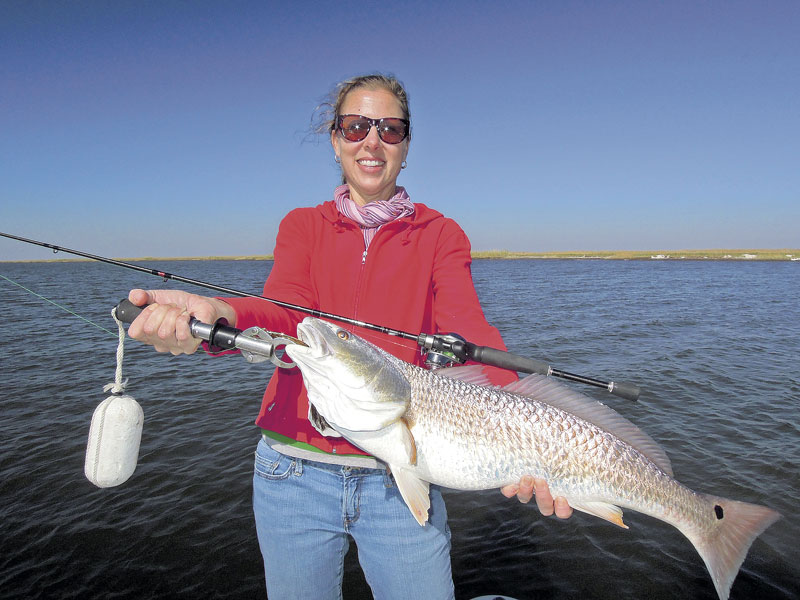
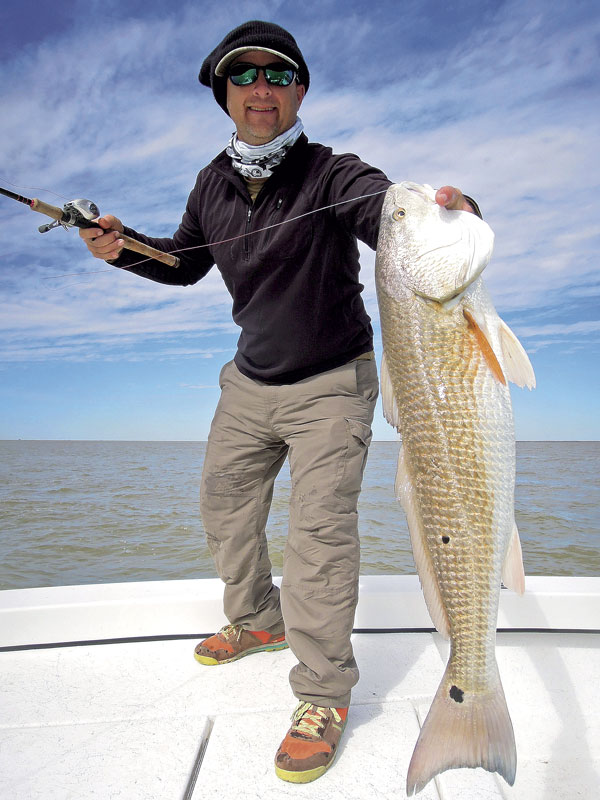
Don’t pass up shallows
Redfish don’t always stay in the deep water, even on icy days. The fish move from the depths to the shallows and back to find the most comfortable temperatures and food. As the sun warms the water, fish become more active. The most aggressive redfish regularly cruise sunny flats to hunt prey. When darkness cools the water, fish return to the depths.
“Redfish are in the deep water, but there’s many more up on the flats,” Thomason confirmed. “It all comes down to water temperature. The fish might stay on the bottom at night or during an overcast day. When it’s sunny and pretty the next day, they move up to the flats because that’s the place to eat.”
In January, many Louisiana sportsmen hunt ducks at first light and return to the camp by mid-morning. Then, they venture out that afternoon for the “cast” portion of a “cast and blast” adventure. Even on a chilly Louisiana day, temperatures can become quite comfortable by late afternoon.
“In the winter, it doesn’t make sense to head out at first light to fish,” Nash said. “Fish become most aggressive during the warmest part of the day. I like to fish from about 10:30 a.m. until 3 p.m. On a good bluebird afternoon, redfish will probably be in the sunny shallows warming up and looking for bait.”
Cold winds routinely blow water out of the marshes during the winter, creating extremely low tides. That leaves black Louisiana mud exposed to the sun where it continues to heat up throughout the day. Even on the most bitter freezing days, sunshine beating down on the water can raise the temperature several degrees. When the tide comes back in and covers those mudflats, redfish roam around looking for prey.
“January is one of my favorite times to fish because of the water falling out,” Thomason said. “All through the coldest months, I’ll run around spooking fish. They are scattered around those flats sunning themselves. Baitfish also move up on those flats to feed and redfish follow them.”
In the spring and fall, many anglers watch for diving birds that could indicate the presence of shrimp or baitfish. The same occurs in the winter, but anglers need to adjust to the season. During the winter, pay the most attention to diving brown pelicans. Ignore migrant white pelicans on the shorelines.
“The key to catching redfish in the winter is to be patient,” Nash summed it up. “People need to fan-cast an area and spend more time at a good spot. Sometimes, we almost need to knock redfish on the head to make them bite. Redfish are opportunistic feeders. They just sit there trying to warm up, but if a shrimp or a piece of cut bait crosses their faces, they’ll take a swipe at it.”


